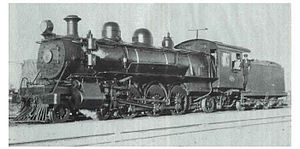- NZR Q class (1901)
-
NZR Q class 
A NZR Q class locomotive Power type Steam Builder Baldwin Locomotive Works, Philadelphia, USA Serial number 19202–19207
19248–19254[1]Build date 1901 Configuration 4-6-2 Gauge 3 ft 6 in (1,067 mm) Cape gauge Driver diameter 49.1 in (1.25 m) Wheelbase 48 ft 4 in (14.73 m) Length 55 ft 4 in (16.87 m) Weight on drivers 30.7 long tons (31.2 t) Locomotive weight 48.0 long tons (48.8 t) Tender weight 24.1 long tons (24.5 t) Locomotive & tender
combined weight72.1 long tons (73.3 t) Fuel type Coal Fuel capacity 5.0 long tons (5.1 t) Water capacity 1,700 imp gal (7,700 L) Boiler pressure 200 psi (1,400 kPa) Firegrate area 40 sq ft (3.7 m2) Cylinders Two Cylinder size 16 × 22 in (41 × 56 cm) Tractive effort 18,340 lbf (81.6 kN) Locomotive brakes Steam Train brakes Vacuum Number in class 13 Number 338-350[1] Locale Auckland - Rotorua
Oamaru - DunedinFirst run 1901-12-24 Retired 1957-12-07 Disposition All scrapped The NZR Q class was an important steam locomotive not only in the history of New Zealand's railway network but also in worldwide railways in general. Designed by New Zealand Government Railways' Chief Mechanical Engineer A. L. Beattie and ordered from the Baldwin Locomotive Works in 1901, they were the first locomotives in the world to be built with the wheel arrangement of 4-6-2. This wheel arrangement came to be known as the Pacific type after the voyage the completed locomotives had to make across the Pacific Ocean to New Zealand. A few instances of the 4-6-2 wheel arrangement are known to have existed prior to 1901, but these were all reconstructions of locomotives that were originally built with a different wheel arrangement, thereby making the thirteen members of the Q class the first "true" Pacifics in the world. The Pacific style went on to become arguably the most famous wheel arrangement in the world.
Contents
Design
The Q class's design stems from the requirement for a locomotive similar to the Ub class with the inclusion of a wide firebox to burn poor quality lignite coal from the South Island and the Waikato.
Operation
In operation, the locomotives proved to be satisfactory rather than brilliant and they suffered from occasional gear problems. They were soon displaced from the most important and difficult work by members of the A and AB classes; in fact, later in life, they were re-boilered with AB boilers.
Withdrawal
They saw out their final years working in Otago and the West Coast and the last Q class locomotive was retired in 1957. No examples of the class were preserved.
The members of this Q class should not be confused with the members of 1878's Q class. As all of the 1878 locomotives had been withdrawn by 1901, the classification was free to be used again.
References
- ^ a b "Q Class 4-6-2 Register". http://www.trainweb.org/nzsteam/q462_reg.htm. Retrieved 2008-02-10.
Further reading
- Heath, Eric, and Stott, Bob; Classic Steam Locomotives Of New Zealand, Grantham House, 1993
External links
- NZR Steam locomotives - Q class
- 1934 article on the development of the Pacific locomotive from The New Zealand Railways Magazine
Categories:- Locomotives of New Zealand
- 4-6-2 locomotives
- Baldwin locomotives
- Cape gauge railway locomotives
Wikimedia Foundation. 2010.
